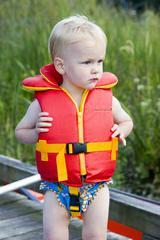|
Toddler Safety - Supervision and Prevention are the Golden RulesA child between 1 and 4 years old is generally regarded as a toddler. Toddler safety is focused on children in this age group because they revel in their new found mobility. They are active and curious and are always on the move; running, jumping and climbing everything in sight.

The trouble is they have no concept of danger. Your toddler will be no exception. That's were we come in. As adults, we provide the safety, we think and anticipate for them. We must anticipate and take preventative steps to reduce the possibility of accidents and teach them what is safe and what is dangerous. We must supervise them. Supervision and prevention are the golden rules. A good resource for tips on toddler safety and information on child safety laws is Safe Kids USA. Safe Kids USA is a member of Safe Kids Worldwide, a global network of organisations whose mission is to prevent accidental injury to children. By being aware of the dangers, taking the necessary preventative steps and providing adult supervision most accidents can be avoided. To aid in this toddler safety process, the list below contains some of the most common causes of child injuries and death in the world today:
Motor Vehicle Accidents cause the most serious injuries and deaths. In most countries it is a legal requirement for a toddler to be suitably restrained in an appropriate safety seat while travelling in a car. You have the responsibility to ensure your child is in an appropriate
car seat.
Choking and Suffocation accidents are also common. They are generally avoided by being careful and vigilant. Don't let your child eat small, round or hard food like nuts, boiled sweets, carrots and popcorn. Check that small items like marbles, beads, buttons, coins and small stones are not lying around on the floor. Ensure all plastic bags and cellophane are stored where a toddler cannot reach them. Check that cords, ribbons, cables, curtain and blind cords are safely stowed away. And be on the lookout for openings where toddlers can get their bodies through but not their heads. Poisoning accidents occur because items such as cosmetics, household cleaners, medicines, pesticides, alcohol and poisonous plants are left or stored in places that toddlers can reach with ease. Keep these items out of reach and preferable locked away. Make use of child resistant closures on doors and cupboards. Drowning mostly occurs in home swimming pools, but can happen wherever water is present. If you are anywhere near water you must watch your toddler constantly. Teach your child to swim as early as possible and while in the learning stage make them wear a flotation device. Ensure your pool is fenced on all sides and for extra protection have a child proof pool cover.
Return from Toddler Safety to Toddler Basics Home Page
|




